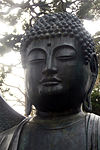| Part of a series on |
| Zen Buddhism |
|---|
 |
| Part of a series on |
| Western Buddhism |
|---|
 |
In Chan and Zen Buddhism, dharma transmission is a custom in which a person is established as a "successor in an unbroken lineage of teachers and disciples, a spiritual 'bloodline' (kechimyaku) theoretically traced back to the Buddha himself."[1] The dharma lineage reflects the importance of family-structures in ancient China, and forms a symbolic and ritual recreation of this system for the monastical "family".[2]
In Rinzai-Zen, inka shōmei (印可証明) is ideally "the formal recognition of Zen's deepest realisation",[3] but practically it is being used for the transmission of the "true lineage" of the masters (shike) of the training halls.[4] There are only about fifty[web 1] to eighty[web 2] of such inka shōmei-bearers in Japan.
In Sōtō-Zen, dharma transmission is referred to as shiho, and further training is required to become an oshō.[web 3]
- ^ Haskel, 2
- ^ Bodiford 2008, p. 264.
- ^ Ford 2006, p. 54.
- ^ Borup 2008, p. 13.
Cite error: There are <ref group=web> tags on this page, but the references will not show without a {{reflist|group=web}} template (see the help page).
© MMXXIII Rich X Search. We shall prevail. All rights reserved. Rich X Search
